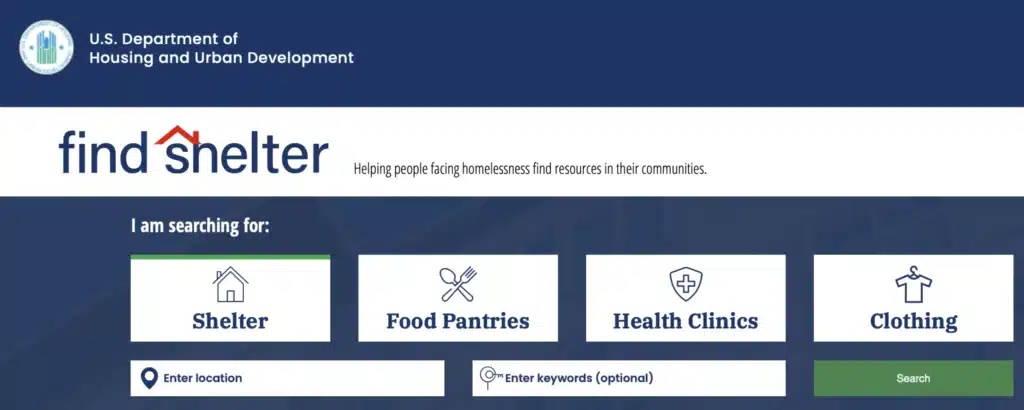If you need a safe place to stay, the HUD Find Shelter tool can help. This free online resource from the U.S. Department of Housing and Urban Development (HUD) connects people with emergency shelters, food pantries, health clinics, and other services. Whether you are homeless, at risk of losing your housing, or in an emergency, this tool helps you find real, verified assistance near you.
Many people don’t know where to turn when they need emergency housing. Searching online can be confusing, and not all shelters are listed in one place. That’s why HUD’s Find Shelter tool is useful and it gives you a direct list of places that provide immediate help.
Here’s how to use it, what to expect when you arrive at a shelter, and other ways to find assistance fast.
What Is the HUD Find Shelter Tool?
The HUD Find Shelter tool is a free online search tool that helps people find local emergency resources. It includes:
- Emergency shelters – Temporary housing for individuals and families
- Food pantries – Places that provide free groceries
- Health clinics – Low-cost or free medical care
- Clothing banks – Locations offering free clothing assistance
It is easy to use, requires no registration, and is available to anyone looking for help. You simply enter your location, choose the type of service you need, and get a list of available resources near you.
Visit the HUD Find Shelter Tool here: https://www.hud.gov/findshelter
What to Expect When You Arrive at a Shelter
Each shelter has different rules and policies. Here’s what you should be prepared for:

1. Some Shelters Require ID
Not all shelters ask for identification, but some do. If you don’t have an ID, call ahead to ask if they will still accept you.
2. Space May Be Limited
Shelters fill up fast, especially in large cities. It’s best to arrive early or call ahead to check availability.
3. Some Shelters Have Rules
To keep residents safe, shelters may have rules like:
- Curfews – You may need to arrive by a certain time.
- No drugs or alcohol – Many shelters require sobriety.
- No pets – Most shelters don’t allow animals, except service animals.
If a shelter has rules you cannot meet, ask if they can refer you to another location.
4. Families May Get Priority
If you have children, some shelters may prioritize you over single adults. Ask if they have family-specific housing options.
5. Additional Services May Be Available
Many shelters offer more than just a place to sleep. You may find:
- Job training programs
- Mental health and counseling services
- Addiction recovery programs
- Help applying for long-term housing assistance
If you need extra help, ask shelter staff about available programs.
How to Use the HUD Find Shelter Tool

Step 1: Go to the Website
Visit HUD’s Find Shelter page on your smartphone, tablet, or computer. The tool works on any device with internet access.
Step 2: Enter Your Location
In the search box, enter one of the following:
- City and state (e.g., Chicago, IL)
- ZIP code (e.g., 60601)
Then, click “Search” to see available services in your area.
Step 3: Select a Service Type
You will see four main categories of services:
- Shelters – Provides temporary housing
- Food Pantries – Free food assistance
- Health Clinics – Medical help for those without insurance
- Clothing Assistance – Free clothes for those in need
Choose the category that fits your situation.
Step 4: Find a Shelter or Resource
The tool will display a list of available locations, including:
- Name of the shelter or organization
- Address
- Phone number
- Website (if available)
You can call ahead to ask about availability, hours of operation, and any requirements.
Other Ways to Find Emergency Shelter
If the HUD Find Shelter tool doesn’t show a shelter near you, try these options:
1. Call 211
Dial 211 from any phone to reach the United Way’s 24/7 helpline. They can connect you with local shelters, food assistance, and housing programs.
2. Contact Local Charities and Churches
Organizations like the Salvation Army, Catholic Charities, and local churches often provide emergency shelter, especially in cold weather.
3. Visit a Homeless Outreach Center
Many cities have drop-in centers where people experiencing homelessness can get meals, showers, and referrals to shelters.
4. Go to a Public Library
Libraries often have resource lists for local shelters and services. Staff may be able to help you find emergency housing options.
5. Check with Your City’s Housing Department
Some cities and counties have emergency housing programs that aren’t listed on the HUD Find Shelter tool. Visit your local government website or call their housing department for more information.
Common Questions About HUD’s Find Shelter Tool
Is the HUD Find Shelter Tool free?
Yes. The tool is completely free to use and does not require any sign-up or registration.
Can I use this tool to find permanent housing?
No. The tool only lists emergency services. If you need long-term housing, check out HUD’s Section 8 program or public housing options.
What if there are no shelters in my area?
Try searching a nearby city or call 211 for more options. Some smaller towns may not have shelters, but nearby larger cities often do.
Do I have to be homeless to use this tool?
No. Anyone in need of food, medical care, or shelter can use it.
What should I do if I feel unsafe at a shelter?
If you feel unsafe, leave and find another shelter. If you are in immediate danger, call 911. You can also ask shelter staff about safer options, including women’s shelters or domestic violence programs.
Final Thoughts: Get Help Fast
If you are in crisis, HUD’s Find Shelter tool is one of the fastest ways to locate emergency housing and essential services. Enter your location, select the type of help you need, and contact a shelter near you.
If you need help right now:
- Use the HUD Find Shelter Tool: https://www.hud.gov/findshelter
- Call 211 for local resources
- Call 911 if you are in danger
You are not alone, there are people and organizations ready to help. The sooner you reach out, the sooner you can find a safe place to stay.

